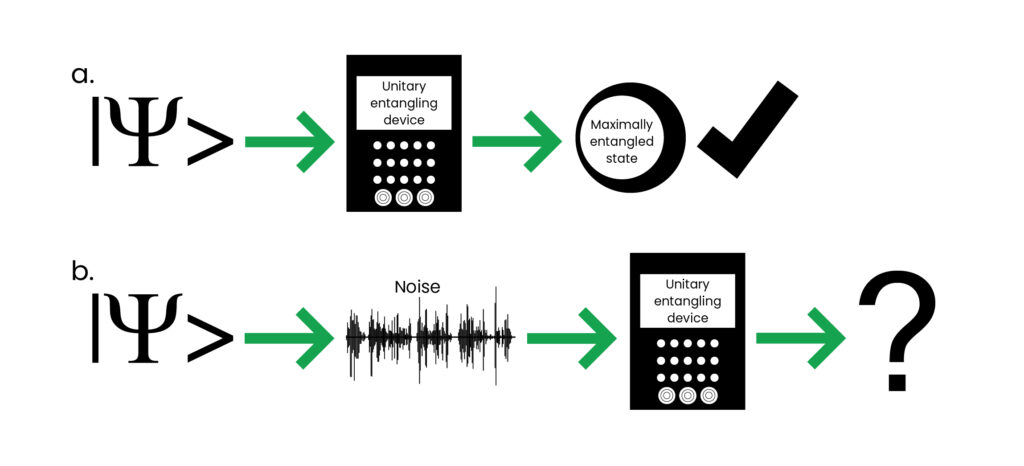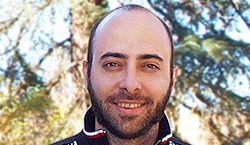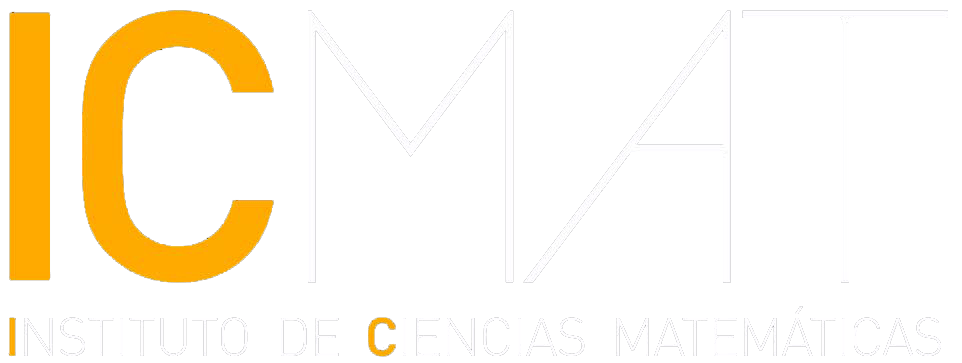
Graphical representation of De Vicente’s result. Image: Laura Moreno-Iraola (ICMAT)
For many quantum technological applications, it is of interest to obtain entangled particles – i.e. quantum particles between which there is a very strong correlation, a phenomenon with no analogue in the classical world. The most useful state for all these applications, regardless of the particular task to be performed, is the so-called maximally entangled state, the existence of which, in the absence of noise, has long been known. It is also known that in realistic situations, where the presence of noise is unavoidable, this state is unattainable. Now, something else has been demonstrated: ‘There can be no universal notion of maximum entanglement outside the idealised noise-free scenario, even when the noise is arbitrarily small. In this case, the best achievable interlaced state will depend on the particular application for which it is to be used’. This is the conclusion of a recent result by Julio de Vicente, full professor at Universidad Carlos III de Madrid and member of ICMAT, published this week in Physical Review Letters. De Vicente talks about it in this following interview.
Ágata Timón García-Longoria (ICMAT)
Question: What is the maximally entangled state and why is it important?
Answer: Entanglement is a form of very strong correlation that can occur between two particles whose behaviour is described by the laws of quantum mechanics. This phenomenon has no analogue in classical mechanics and is behind many of the promising applications of quantum technologies. One of the most striking examples is the establishment of a secret key for cryptographic applications. In many scenarios, the verification that the two parties involved share entangled states is the cornerstone of the security of the protocol and ensures that the communication cannot be decrypted by a third party. Another example is quantum teleportation, which allows transmitting an unknown quantum state to a remote location via a classical communication channel. Without entanglement, these applications fail: we have no guarantee that the communication is not being eavesdropped on or that the teleportation is reliable.
Like many other physical properties, entanglement manifests itself in different forms, and of all the possible states describing a two-particle quantum system – called bipartite – there are different degrees of entanglement. Among them all, there is one that is the maximally entangled state: the best entangled state available, regardless of the particular application one has in mind. In the examples above, of quantum cryptography and quantum teleportation, the maximally entangled state guarantees the highest possible level of privacy and makes teleportation perfect, respectively. In mathematical terms, this state maximises all possible measures that quantify entanglement in some way.
Q: Is it possible to obtain this state, and what does your work say about it?
A: In practice, due to the presence of noise, this state is unattainable. However, we could ask: given a well-characterised noise source, once the noise level is fixed, is there a best interleaved state? My work answers this question in the negative. There can be no universal notion of maximum entanglement outside the idealised scenario, even when the noise is arbitrarily small. In this case, the best achievable interlaced state will depend on the particular application for which it is to be used.

Julio de Vicente is a full professor at the Universidad Carlos III de Madrid and a member of the ICMAT
Q: What was known about this question so far?
A: In 2001, it had been shown that, for any given level of noise, there exists a state that maximises various measures of entanglement of relevance. This had led to the hope that a maximally entangled state existed in the noisy case, but for this, it was necessary to show that this state maximises any measure of entanglement, not just a few. However, these quantities are exceptionally complicated to evaluate and, in fact, we know that they lead to computationally difficult problems. That is why not much progress has been made on this question.
Q: How have you approached the question?
A: In this work, the main idea is, instead of sticking with these hard problems, to consider an ordering relation between states, which fixes whether a measure of entanglement is larger or smaller. What we have shown is that it is impossible for there to be a maximum element, better than any other. Once this was done, we automatically obtained particular entanglement measures, which serve as a counterexample to the hope that arose in 2001.
Q: And what does this imply in relation to cryptography and quantum teleportation?
A: If we use ‘less’ entangled states, cryptography and teleportation are still possible, but the process of distilling the secret key is more inefficient in the former case and the transmission is not completely faithful in the latter. And, unlike the noiseless case, the result of this work indicates that, for the same level of noise, the optimal state for cryptography may be different from the state that teleports best.
Q: In practice, have these phenomena been observed?
A: I am not an expert in this part of the field, but the experimental preparation of entangled states for two-particle systems is very advanced. The first experiments were done in the 1970s, to verify violations of the so-called Bell inequalities. In fact, in 2022, the Nobel Prize was awarded to Alain Aspect, John F. Clauser and Anton Zeilinger for their pioneering work on the experimental implementation of entangled states with photons for quantum information theory applications. It is now possible to prepare the maximally entangled state of two particles in very different physical systems: such as the polarisation of photons, the energy levels of trapped ions or in superconducting circuits. Experiments in these cases reach very high fidelities, even above 99%, but never 100%, i.e. the maximally entangled state. This has allowed spectacular results such as, for example, teleporting from the island of La Palma to Tenerife – more than 140 kilometres apart – or even from the Earth to a satellite in space – more than 1000 kilometres away.
Q: What are the next steps on this topic?
A: In the specific context of my work, it should be said that the proof of the non-existence of a maximally entangled state in the noisy case is based on ad hoc constructed entanglement measurements, with no clear operational meaning. It would be interesting to identify specific quantum information protocols where the optimal state at the same noise level changes. On the other hand, the result refers to a concrete, very reasonable, but specific, way of understanding what ‘the same noise level’ means. It could be investigated whether the result is still true for other notions. From a more general perspective, a major challenge is to further advance our understanding of the structure of entanglement in the much more complex multi-party case, and in particular to better understand for which tasks it is advantageous and to be able to develop new protocols and applications.
Reference:
“Maximally entangled mixed states for a fixed spectrum do not always exist”, Julio de Vicente. Physical Review Letters. DOI: 10.1103/PhysRevLett.133.050202
Julio de Vicente
Julio de Vicente is full professor at Universidad Carlos III de Madrid (UC3M) and member of the ICMAT. His research interests focus on quantum information theory, especially entanglement theory, non-locality and quantum resource theories.
He graduated in Physics from the Universidad Autónoma de Madrid in 2002, and obtained his PhD in Mathematics from the Universidad Carlos III de Madrid in 2008. He has held postdoctoral positions at the Universitat Autònoma de Barcelona (2008-2010) and at the Universität Innsbruck (2010-2013). Since 2013 he has been working in the Department of Mathematics at UC3M, initially as assistant professor and, since 2019, as full professor.
—
This content has been automatically translated. The original text may differ slightly.
